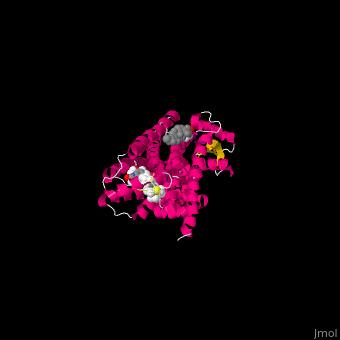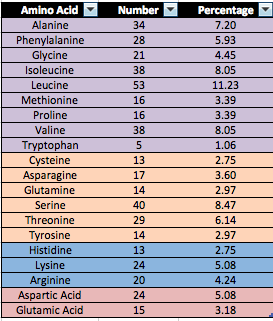Beta-2 adrenergic receptor
From Proteopedia
AbstractK2 and other newly popularized drugs laced with synthetic cannabinoids, which mimic those found in marijuana, bind similarly to G protein-coupled receptors found throughout the body and nervous system. CB1, in particular, is comprised of 472, mostly nonpolar amino acids that fold into a secondary structure consisting of ten alpha helices and one beta pleated sheet forming a transmembrane domain. Binding to endogenous and exogenous ligands alike, CB1 acts as an activator in a signal transduction pathway to aid in regulating many major bodily systems. HistoryFirst emergent in Europe in 2004, an herbal incense product known as Spice or K2 was quickly utilized all over the world as a synthetic form of marijuana. Although sold legally in many areas as a “natural incense” that is “not for human consumption”, K2 is a plant-based material with traces of astoundingly potent synthetic cannabinoids, a fact that many users and retailers alike do not fail to recognize. Synthetic cannabinoids (SCBs) are chemically derived forms of the naturally-occurring psychotropic cannabinoid, tetrahydrocannabinol (THC), found in marijuana [1][2]. Cannabinoids bind and activate cannabinoid receptors, CB1 and CB2, which are found throughout the body [1]. CB1 is primarily found in the cerebellum as well as the hippocampus, hypothalamus, cerebral cortex, striatum and brainstem; all vital areas of the central nervous system [1]. Although SCBs are chemically similar to THCs, which exhibit relatively mild side effects when used recreationally, the use of K2 has been linked to many serious health conditions. Due to the delocalization of CB1 receptors throughout the body and in crucial parts of the CNS that regulates bodily functions, K2 can affect many systems of the body simultaneously. Cardiovascularly, K2 can cause tachycardia, tachyarrhythmia, hypertension and, in rare cases, myocardial infarction [2][3][4]. Neurologically, K2 can cause extreme paranoia, psychosis, hallucinations, memory and learning disruptions, dependence and even seizures [1]. StructurePrimaryThe cannabinoid receptor (CB1) has a total of 472 amino acids. Of the 472 amino acids, 52.75% are nonpolar, 26.91% are uncharged polar, and 20.34% are polar (12.08% basic and 8.26% acidic). The location of the amino acid residues can be viewed by selecting the name of each amino acid in the table below.
SecondaryThe secondary structure of CB1 consists of ten and one . Of the ten α-helices, eight are roughly identical in size and align parallel to one another to form a typical transmembrane-type domain. The remaining two α-helices are shorter in length, run perpendicular to the other eight, and are located at one end of the receptor. On the opposite end of the receptor, an antiparallel β-sheet is located in the middle of the transmembrane domain formed by the eight parallel helices. While the structure overall has a low composition of polar amino acids, a large portion are located within this β-sheet, hinting at the role it may play in the function of the receptor.
TertiaryA homology model for the tertiary structure of CB1 is shown in the upper right-hand corner of the page with the use of JSmol in Proteopedia [5][6]. MechanismIn neurons, CB1 is presynaptic and modulates neurotransmitter release by retrograde signaling, meaning the message travels from postsynaptic neurons to presynaptic neurons. The portion of the receptor with eight α-helices spans the membrane, giving an active site on the extracellular portion of the receptor. This active site is filled with side chains, allowing for hydrogen bonding of the , which is nonpolar. When the agonist binds to CB1, a conformational change occurs in the receptor. The β-sheet and other two α-helices are intracellular, and after the conformational change this portion produces a binding site for a heterotrimeric G-protein [1]. This heterotrimeric protein is bound to guanosine diphosphate (GDP), but the interaction causes an exchange of GDP to guanosine triphosphate (GTP), which catalyzes the dissociation of the heterotrimeric G-protein and promotes several signaling cascades. This activity inhibits intracellular cyclic AMP (cAMP) production, inhibits the opening of some voltage gated calcium channels, and activates some potassium channels [1]. The inhibition of opening calcium channels and the activation of potassium channels, which both cause hyperpolarization, make it more difficult to excite an action potential in a neuron. There is an increase in the amount of dopamine present in the brain, which promotes the brain reward system. This is due to inhibition of dopaminergic neurons that would take up this dopamine. The agonists cause an inhibitory effect on neuronal function [1]. In contrast to cannabis, K2 is synthetic and contains multiple SCBs that participate in drug-drug interactions. These interactions promote potency of synergistic effects, but they also contribute negative side effects [7].
FunctionCB1 is one of two receptors in the human body that recognizes five endocannabinoid compounds as well as exogenous cannabinoids like THC and K2. The CB1 receptor is a G protein-coupled receptor located primarily in the nervous system [8]. The primary function of the CB1 receptor is to bind endogenous and exogenous ligands to activate signal transduction pathways for the cells in which they are located [8]. The function of CB1 receptors thus depends on the location of the receptor as well as the type of ligand binding to the receptor. As a result, CB1 receptors are involved in regulating a variety of physiological functions including regulation of neurotransmitters, pain modulation, memory, motor control, control of appetite, and regulation of anxiety. Regulation of NeurotransmittersThe highest concentration of CB1 receptors is found within presynaptic nerve terminals [9]. When ligands bind to CB1 receptors in presynaptic nerve terminals, calcium channels are inhibited. The release of calcium is a key component of the nerve signal transduction pathway that results in the release of neurotransmitters in the synaptic cleft. As a result, activated CB1 receptors are able to regulate the release of neurotransmitters. CB1 receptors have been shown to inhibit the release of glutamate, acetylcholine, and noradrenaline [8]. Additionally, activated CB1 receptors suppress the activity of GABAergic neurons, which control neurons responsible for the release of dopamine [10]. By suppressing GABAergic neurons, dopamine levels in the brain are increased. This action of CB1 receptors is responsible for the pleasure associated with THC use and the potential for abuse of exergonic cannabinoids. Pain ModulationCB1 receptors are also highly expressed in areas of the nervous system involved with pain modulation, specifically in the dorsal root ganglia [8]. This is one of the most well known functions of CB1 receptors and is responsible for the pain reduction effects associated with THC. MemoryCB1 receptors are also highly concentrated in the hippocampus. The hippocampus is a region of the brain involved with learning and memory [10]. The relatively high density of CB1 receptors in the hippocampus is responsible for the memory-altering effects of THC and other cannabinoids [11]. Motor ControlCB1 receptors are also located in the basal ganglia, a region of the brain responsible for the coordination of movement [8]. The binding of endocannabinoids has been shown to play a critical role in fine motor control. Specifically, it has been shown that CB1 receptor binding is decreased in patients with neurodegenerative diseases such as Parkinson’s and Huntington’s disease. In contrast, CB1 receptors have a lesser influence on gross motor control due to the lower concentration of receptors in the cerebellum, which is responsible for coordinating gross motor control [8]. Control of AppetiteCB1 receptors play a significant role in appetite control by regulating food intake, influencing fat accumulation, and altering lipid and glucose metabolism. Activation of CB1, results in the release of hormones that promote hunger and thus stimulate appetite [12]. CB1 also interacts with the neuropeptides controlling functions of lipid and glucose metabolism. As a result, the endogenous function of CB1 receptors is key to controlling homeostasis in energy balance [12]. Furthermore, hyperactivity of these functions is associated THC use. This function of CB1 receptors may play a key role in the development of obesity treatments. Regulation of AnxietyCB1 receptors are responsible for mediating the anti-anxiety effects of cannabinoids, like THC. In low doses, cannabinoids reduce anxiety; however, high doses of cannabinoids act to increase anxiety [3]. This is one reason why synthetic cannabinoids like K2, an extremely potent synthetic cannabinoid, produce the harmful side effect of extreme anxiety. Group:SMART:A Physical Model of the beta-Adrenergic Receptor 3D structure of β-2 adrenergic receptor
See also: References
| ||||||||||||||||||||||
Proteopedia Page Contributors and Editors (what is this?)
Joel L. Sussman, Tala Curry, Michal Harel, Alexander Berchansky, Jaime Prilusky


